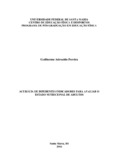| dc.creator | Pereira, Guilherme Adroaldo | |
| dc.date.accessioned | 2018-04-20T15:28:05Z | |
| dc.date.available | 2018-04-20T15:28:05Z | |
| dc.date.issued | 2016-12-16 | |
| dc.identifier.uri | http://repositorio.ufsm.br/handle/1/13028 | |
| dc.description.abstract | The present study had as objective to analyze the accuracy of different indicators of the nutritional status of adults of both sexes, having as reference method the hydrostatic weighing (HW). A total of 280 subjects (210 men and 70 women), aged between 17 and 48 years old, were investigated. The results of body fat percentage (%BF) obtained through the University of Navarra-Body Adiposity Estimator (CUN- BAE), body adiposity index (BAI), skinfold estimation equations (E-DC) and bioelectrical impedance (BIA). We also analyzed the results of the body mass index (BMI), new body mass index (BMI2.5), body fat mass index BFMI and the body mass index adjusted by the fat mass (BMIfat), all of them using HW as the reference method. The results indicated that no significant differences were observed between the %BF measures of the E-DC and BIA indicators and the HW for the male group; however, for the female group, despite the analyzes indicating agreement, the %BF values presented statistically different from those obtained with the reference method. The BAI presented an acceptable estimation error when evaluating the female group and the CUN-BAE presented a tendency to overestimate the values of %BF, in both sexes. On the other hand, the BFMI presented the highest agreement value, but classified as discrete (k=0.21). The other indexes presented small agreement with the results of the reference method (k <0.20). It is possible to conclude that, in a general way, the E-DC and BIA indicators were the ones that presented the best results, with the E-DC being more efficient to evaluate the male subjects. In addition, none of the indexes investigated showed good accuracy in assessing the nutritional status of adults, although they showed results of correlation with the reference method, did not reach the minimum criterion of agreement. | eng |
| dc.language | por | por |
| dc.publisher | Universidade Federal de Santa Maria | por |
| dc.rights | Attribution-NonCommercial-NoDerivatives 4.0 International | * |
| dc.rights.uri | http://creativecommons.org/licenses/by-nc-nd/4.0/ | * |
| dc.subject | Composição corporal | por |
| dc.subject | Métodos de avaliação | por |
| dc.subject | Antropometria | por |
| dc.subject | Pesagem hidrostática | por |
| dc.subject | Body composition | eng |
| dc.subject | Evaluation methods | eng |
| dc.subject | Anthropometry | eng |
| dc.subject | Hydrostatic weighing | eng |
| dc.title | Acurácia de diferentes indicadores para avaliar o estado nutricional de adultos | por |
| dc.title.alternative | Accuracy of different indicators to evaluate the nutritional status of adults | eng |
| dc.type | Dissertação | por |
| dc.description.resumo | O presente estudo teve como objetivo analisar a acurácia de diferentes indicadores do estado nutricional de adultos, de ambos os sexos, tendo como método de referência a pesagem hidrostática (PH). Foram investigados 280 sujeitos (210 homens e 70 mulheres), com idade entre 17 e 48 anos, dos quais se analisou os resultados de percentual de gordura corporal (%GC) obtidos através do Clínica Universidad de Navarra-Body Adiposity Estimator (CUN-BAE), do índice de adiposidade corporal (IAC), das equações de estimativa a partir de dobras cutâneas (E-DC) e da impedância bioelétrica (IB). Também foram analisados os resultados do Índice de Massa Corporal (IMC), do novo Índice de Massa Corporal (IMC2,5), do Índice de Massa Gorda (IMG) e do Índice de Massa Corporal ajustado pela Massa Gorda (IMCgordura), todas as análises tendo como método de referência a PH. Os resultados indicaram que não foram observadas diferenças significativas entre as medidas de %GC dos indicadores E-DC e IB e a PH para o grupo masculino, no entanto, para o grupo feminino, apesar das análises indicarem concordância, os valores de %GC apresentaram-se estatisticamente diferentes dos obtidos com o método de referência. O IAC apresentou erro de estimativa aceitável ao avaliar o grupo feminino e o CUN-BAE apresentou tendência de superestimar os valores de %GC, em ambos os sexos. Por outro lado o índice IMG apresentou o maior valor de concordância, porém classificado como discreto (k = 0,21). Já os demais índices apresentaram concordância pequena com os resultados do método de referência (k<0,20). É possível concluir que, de uma forma geral, os indicadores E-DC e IB foram os que apresentaram os melhores resultados, sendo que o E-DC se mostra mais eficiente para avaliar indivíduos do sexo masculino. Além disso, nenhum dos índices investigados apresentou boa acurácia para avaliar o estado nutricional de adultos, pois apesar de mostrarem resultados de correlação com o método de referência, não atingem o critério mínimo de concordância. | por |
| dc.contributor.advisor1 | Matheus, Silvana Corrêa | |
| dc.contributor.advisor1Lattes | http://lattes.cnpq.br/8067391099670818 | por |
| dc.contributor.referee1 | Copetti, Fernando | |
| dc.contributor.referee1Lattes | http://lattes.cnpq.br/3441292649893301 | por |
| dc.contributor.referee2 | Moraes, Cristina Machado Bragança de | |
| dc.contributor.referee2Lattes | http://lattes.cnpq.br/3931512755898907 | por |
| dc.creator.Lattes | http://lattes.cnpq.br/6918623219662344 | por |
| dc.publisher.country | Brasil | por |
| dc.publisher.department | Educação Física | por |
| dc.publisher.initials | UFSM | por |
| dc.publisher.program | Programa de Pós-Graduação em Educação Física | por |
| dc.subject.cnpq | CNPQ::CIENCIAS DA SAUDE::EDUCACAO FISICA | por |
| dc.publisher.unidade | Centro de Educação Física e Desportos | por |



